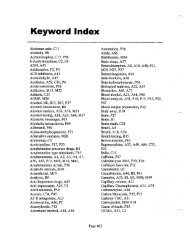ToxTalk Volume 19-3 - Society of Forensic Toxicologists
ToxTalk Volume 19-3 - Society of Forensic Toxicologists
ToxTalk Volume 19-3 - Society of Forensic Toxicologists
You also want an ePaper? Increase the reach of your titles
YUMPU automatically turns print PDFs into web optimized ePapers that Google loves.
FROM THE HEALTH AND SAFETY COMMITTEE <br />
Members: Daniellsenschmid (Chair), John Cody, Laurel Farrell and Elizabeth Marker<br />
In this Issue <strong>of</strong> <strong>ToxTalk</strong> the Health and Safety Committee is pleased to include an article about tuberculosis and the seconP'--,·,<br />
installment <strong>of</strong> a senes<strong>of</strong> bibliographies <strong>of</strong> health and safety related topics. Please feel free to submit comments \<br />
suggestions to: Daniel Isenschmid. Ph.D., Wayne County Medical Examiners Office, 1300 E. Warren, Detroit, MI 48207<br />
TUBERCULOSIS: HEALTH AND SAFETY IN THE FORENSIC LABORATORY<br />
Submitted by: Elizabeth Marker, Ph. D.<br />
Tuberculosis (TB), after a thirty year decline, has shown an eighteen percent increase in Incidence since <strong>19</strong>85. Of <br />
particular concern are Mycobacterium tuberculosis which show resistance to two or more <strong>of</strong> the antibiotics used in treatment. <br />
The groups considered to be a high risk for active disease include blacks, Hispanics, Asian and Pacific islanders, native <br />
Americans, intravenous drug users, the elderly and people with compromised immune systems such as those with HIV 1 .<br />
Many <strong>of</strong> these groups closely correspond to the constituency <strong>of</strong> Medical Examiner/Coroner systems. It is Important, therefore,<br />
that forensic laboratory staff recognize potential risks for exposure to TB. .<br />
TB is spread in the general population by close and prolonged exposure to droplet nuclei containing the bacteria.<br />
These aerosol droplets form when a living patient coughs, sneezes, spits or even sings. The chance <strong>of</strong> infection is dose<br />
dependent: the greater the exposure to droplet nUClei, the greater the risk. The droplets are from 1-5 microns in size, small<br />
enough to remain suspended in the air and to be carried by ambient air currents. In the forensic area, exposure is by<br />
aerosolization <strong>of</strong> body fluids during an autopsy or during preparation <strong>of</strong> samples for analysis.<br />
In the autopsy room, droplets can be generated by compression <strong>of</strong> the chest during the procedure and through the use<br />
<strong>of</strong> saws. In the laboratory, aerosols can be produced during tissue homogenization or any procedure which forcibly mingles<br />
sample and air such as pressurized "blow out~ <strong>of</strong> transfer pipettes with automated pipettors. Protection against these hazards<br />
involves the use <strong>of</strong> engineering controls and appropriate work practices. Engineering controls include proper ventilation <strong>of</strong><br />
rooms and use <strong>of</strong> ventilating hoods. The autopsy room, with large amounts <strong>of</strong> aerosols, should have negative pressure and<br />
direct ventilation to the outside. In the laboratory, laminar flow hoods with HEPA filters should be used for all processes which<br />
produce significant amounts <strong>of</strong> aerosolization, such as homogenizing speCimens. ~,<br />
The balance <strong>of</strong> laboratory safety relative to TB involves administrativ~ controls and common sense. The proper u~<br />
<strong>of</strong> universal personal protection (barrier protection) should provide a reasonable degree <strong>of</strong> protection against all infectious~<br />
hazards, including TB. However. dust or dust/mist masks have not been shown to protect against droplet nuclei; the only<br />
accepted respiratory barrier is a respirator with an HEPA filter. These masks are expensive and require periodic fit check<br />
testing. These respirators are in common use in autopsy rooms. In the laboratory, common sense would suggest that all<br />
procedures which could cause the formation <strong>of</strong> an aerosol be done in properly ventilated areas. The use <strong>of</strong> disposable<br />
glassware could reduce or eliminate any hazards associated with cleaning. Work areas should be periodically disinfected.<br />
Finally, the tuberculin skin test should be administered at least once per year to all personnel directly involved with<br />
autopsy specimens. A positive test requires further medical evaluation .<br />
Tuberculosis is preventable .. By using good laboratory practice and appropriate protective equipment the risk <strong>of</strong><br />
infection to laboratory personnel can be reduced to an acceptable minimum.<br />
1 Dooley, et al.,Guldelines for Preventing the Transmission <strong>of</strong> Tuberculosis in Health-Care Settings, with Special Focus on<br />
HIV-Related Issues. Morbidity and Mortality Weekly Report, Centers for Disease Control, Dec. <strong>19</strong>90, Vol. 39/ No. RR-17.<br />
BIBLIOGRAPHY;<br />
BIOLOGICAL HAZARDS (PART II)<br />
Submitted by: Daniellsenschmid, Ph.D.<br />
W.A. Nichols. Management· <strong>of</strong> occupation exposure to potential blood-borne Infections. Considerations for development <strong>of</strong> <br />
<strong>of</strong>fice procedures to handle "needlestick injuries." Ark. Dent. 62 (3):18-22 (<strong>19</strong>91). <br />
R.B. Otero. Universal precautions for handling body fluids. Therapeutic Drug Monitoring and Toxicology In-Service Training <br />
and Continuing Education 11 (7): 7-12 (<strong>19</strong>90). American Association for Clinical Chemistry, Inc. Washington, D.C. <br />
G. Pugliese. Occupational Safety and Health Administration moves blood-borne pathogen compliance to the front bumev--...<br />
[editOrial]. Am. J. Infect. Control 20 (4): 167-169 (<strong>19</strong>92).<br />
P. Rodriques~ Handling and disposal <strong>of</strong> infectious waste in the <strong>of</strong>fice setting. Orthop. Nurs. 10 (5): 24-26 (<strong>19</strong>91).<br />
(continued next page)<br />
ToxToIk <strong>Volume</strong> <strong>19</strong>, No.3 (September <strong>19</strong>93) Page 4
















